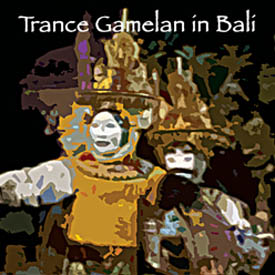 “Trance” as denoting a specific type of music is pretty much a Western concept, although it recognizes the power of music to alter our mental state. In other traditions, music is not always, or even usually, a separate event — most peoples don’t have what we in the West would call “concerts.” Music, dance and ritual are all part of a ceremony, which is a point brought home by Trance Gamelan in Bali. The examples on this CD are all from temple rituals in observance of various holidays, or, indeed, from ceremonies that we might consider secular.
“Trance” as denoting a specific type of music is pretty much a Western concept, although it recognizes the power of music to alter our mental state. In other traditions, music is not always, or even usually, a separate event — most peoples don’t have what we in the West would call “concerts.” Music, dance and ritual are all part of a ceremony, which is a point brought home by Trance Gamelan in Bali. The examples on this CD are all from temple rituals in observance of various holidays, or, indeed, from ceremonies that we might consider secular.
The disc starts with music from a temple ceremony near Ubud, with the music of a beleganjur, a “gamelan of walking warriors” — what we would consider a marching band. I might point out in this context that a gamelan is composed almost entirely of percussion instruments, which might lead you to believe that rhythm is a key element — and you would be correct. This is a live recording, and the participants are several gamelan (as well as the congregation, albeit they’re not official “participants” in the music-making). The resulting sounds, instead of the cacaphony one might expect, becomes a richly textured thing, driven by the rhythms of the various gamelan, which seem to interweave as though performed by one ensemble.
The second track brings us preparations for a temple ceremony at Tanganan, a village on the eastern side of Bali. The village is the repository of many ancient, pre-Hindu traditions, and remains deliberately isolated. This is rehearsal, beginning with children playing on the instruments (which is encouraged), gradually replaced by the performers as they filter in. It’s a leisurely sort of beginning, and as it progresses, the crowd noise builds. The piece begins in fragments, only gradually taking shape. Toward the end of the piece, the rhythm changes and becomes much more “trancelike” — there also seems to be more intensity in the crowd noises, almost a frenzy of calls and exclamations.
The third track is from a dance contest, featuring Jauk and Barong dances. The Barong, in particular, is associated with trance states. This is particularly hypnotic, the repetitive, circular forms of the music lending themselves to a state of mind that is not entirely directed by conscious thought. It also seems to juxtapose rapid figures on some instruments against a much more relaxed melody from other members of the ensemble, producing a fine tension. I think this might be a reflection of the need in Balinese spiritual life to maintain balance, as noted by Daniel Patrick Quinn in his essay. It’s a fairly common idea in non-Western cultures, and one that we seem to have observed once upon a time, although no longer.
It’s a fascinating selection of music, illuminated by Quinn’s notes on the context of ceremony and belief in Bali. It’s also an interesting commentary on what we experience, whether consciously or not, while listening to music.
(Felmay, 2010; produced from 1994 field recordings by John Noise Manis)
